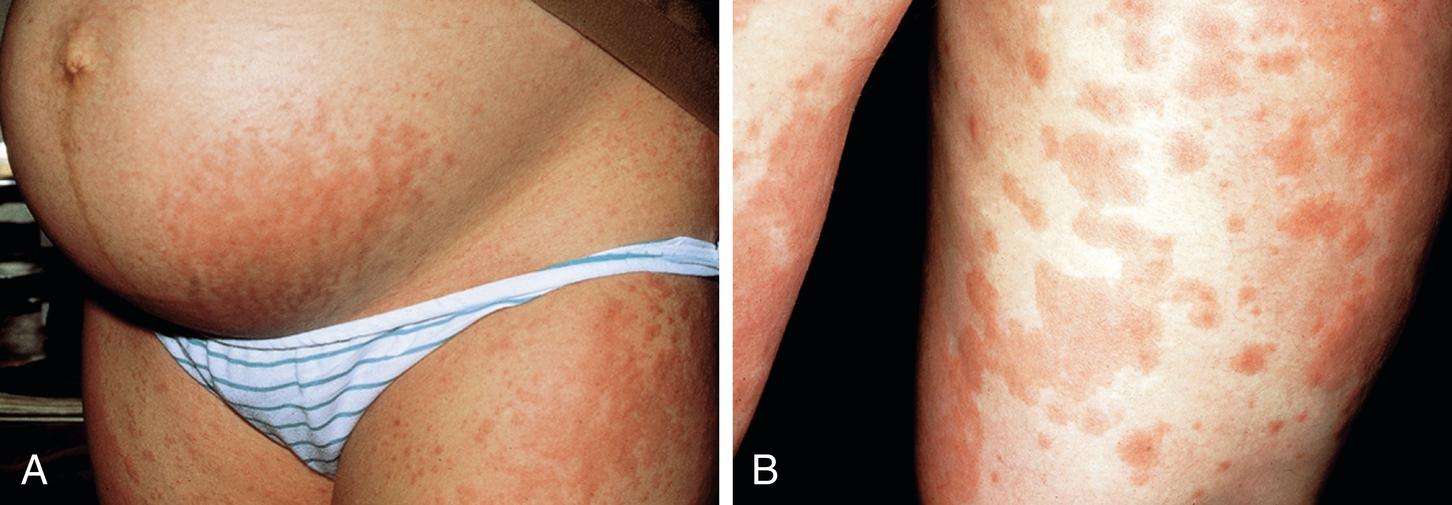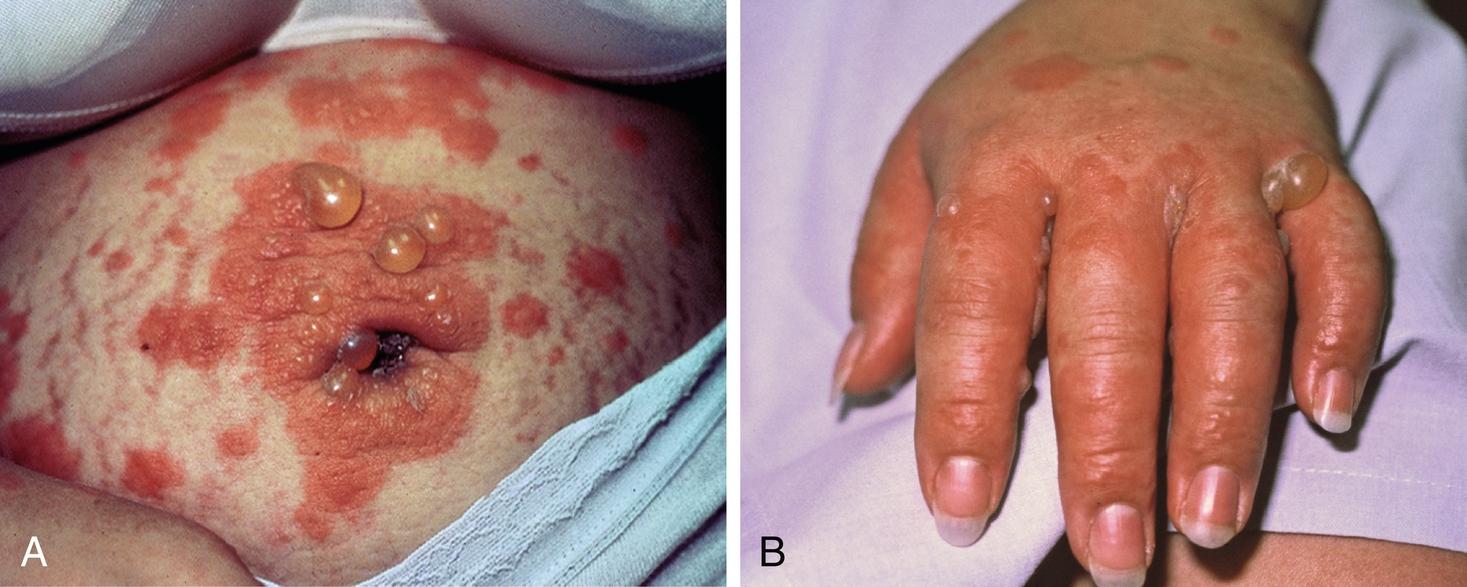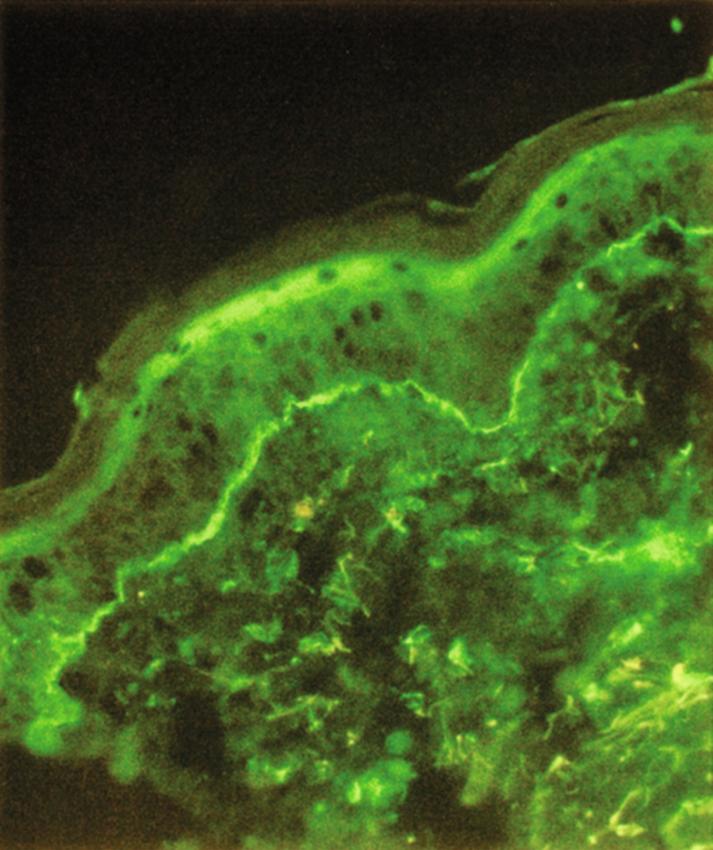Physical Address
304 North Cardinal St.
Dorchester Center, MA 02124
Polymorphic eruption of pregnancy (PEP)
Pemphigoid gestationis
Atopic eruption of pregnancy
Intrahepatic cholestasis of pregnancy (ICP)
Ambros-Rudolph CM, Müllegger RR, Vaughan-Jones SA, Kerl H, Black MM. The specific dermatoses of pregnancy revisited and reclassified: results of a retrospective two-center study on 505 pregnant patients. J Am Acad Dermatol. 2006;54(3):395–404.
Polymorphic eruption of pregnancy or PEP (also known as pruritic urticarial papules and plaques of pregnancy, or PUPPP) has an incidence of 1 in 160 pregnancies and is most common in primigravidas. Excessive maternal weight gain and pregnancy with multiple gestations have also been associated with the development of PEP. The onset of PEP is usually in the late third trimester or sometimes postpartum. The pruritic, erythematous papules and plaques are usually first seen in the abdominal striae (stretch marks) and then spread to the chest, trunk, and extremities. The papules and plaques typically spare the palms, soles, face, and mucous membranes. Large vesicles or bullae are uncommon, although pinpoint vesicles may be seen ( Fig. 59.1 ).

Vaughan Jones S, Ambros-Rudolph C, Nelson-Piercy C. Skin disease in pregnancy. BMJ. 2014;348:g3489.
The pruritus associated with PEP can be very uncomfortable for the mother. There are no fetal sequelae. The skin lesions and pruritus associated with PEP usually spontaneously resolve within 1 or 2 weeks after delivery.
Topical corticosteroids and oral antihistamines are the most common methods of treatment. However, the efficacy of oral antihistamines in treating the pruritus of PEP is questionable. Systemic corticosteroids are used in severe cases.
Bechtel MA. Pruritus in pregnancy and its management. Dermatol Clin. 2018;36(3):259–265.
Pemphigoid gestationis. It may be difficult to clinically differentiate PEP from pemphigoid gestationis.
Pemphigoid gestationis (also called herpes gestationis or gestational pemphigoid) is an autoimmune subepidermal bullous disorder of pregnancy that may start in the second trimester, the third trimester, or in the postpartum period. The skin lesions are characterized by urticarial papules and plaques, which then progress into painful bullae. The lesions of pemphigoid gestationis initially present periumbilically ( Fig. 59.2 A ) and then spread to involve the trunk and extremities ( Fig. 59.2 B), usually sparing the face.

Kushner CJ, Concha JSS, Werth VP. Treatment of autoimmune bullous disorders in pregnancy. Am J Clin Dermatol. 2018;19(3):391–403.
Bullous pemphigoid antigen 2 (BPAG2) is a 180-kDa transcellular glycoprotein that is part of the hemidesmosome (a structure that binds epithelial cells to the basement membrane of the epidermis). Immunoglobulin G (IgG) binds to BPAG2 and triggers the classic complement pathway leading to a deposition of C3 along the basement membrane zone ( Fig. 59.3 ). Deposition of complement along the basement membrane zone leads to a recruitment of inflammatory cells, particularly eosinophils. This cascade ultimately leads to a release of proteolytic enzymes that cleave portions of the epidermis from the dermis.
Pemphigoid gestationis is an autoimmune disease that occurs during pregnancy and it is characterized by IgG 1 antibodies directed at BPAG2 (BP180) in the basement membrane zone.
Direct immunofluorescent study demonstrates linear C3 and/or IgG along the basement membrane zone and is the test of choice to establish the diagnosis.
The primary lesions of pemphigoid gestationis consist of urticarial plaques and/or blisters.
The umbilical area is preferentially affected in pemphigoid gestationis and can be a clue to the diagnosis.
Neonates of mothers with pemphigoid gestationis may be premature, may demonstrate a lower birth weight, and may occasionally demonstrate transient blisters, but are otherwise healthy.

HLA-DR3 and HLA-DR4.
Kushner CJ, Concha JSS, Werth VP. Treatment of autoimmune bullous disorders in pregnancy. Am J Clin Dermatol . 2018;19(3):391–403.
Become a Clinical Tree membership for Full access and enjoy Unlimited articles
If you are a member. Log in here